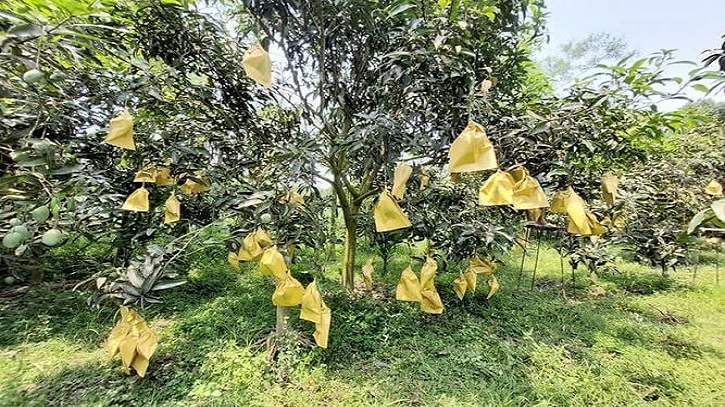
Fruit-bagging technology has been promoted in mango orchards in the region, including its vast Barind tract, commercially to protect mango from pest attack besides facilitating the farmers to get quality yield for the last couple of years. BSS
The method is being applied in growing all mango varieties like Khirshapat, Gopalbhog, Langra, Amrapali, Gauromati, Fazli and Himsagar.
Abul Hossain, a farmer of Premtali village under Godagari upazila, said fruit bagging method keeps fruits fresh and spot-free. He spent Taka 1,24,800 to
purchase the bag for 32,000 mangoes.
At present, only medium and large farms are using fruit bags as small farms remain unable to fund such an expense.
Mango is the leading seasonal cash crop of the country's northwest region and dominates the economy in the region, particularly Rajshahi, Naogaon and
Chapainawabganj districts.
Fruit bags are used during the months of April and May, just ahead of the
paddy harvest.
According to the Department of Agriculture Extension (DAE) sources, there are about 31 lakh mango trees of different ages and varieties on some 34,500
hectares in the region with creation of many more new mango orchards and increased mango farming in the homesteads in recent years.
If the bags are used substantially, use of harmful chemical insecticides and pesticides can be reduced to a greater extent on the huge trees. Thus the technology will open up a new door of exporting mangoes of the three districts famous for the delicious fruit to various foreign markets.
In addition, the bags help keep the mangoes dry inside a controlled temperature, which extends the fruit's longevity so that farmers can take them to the market at will.
Monzurul Huda, former director of DAE, said the demand for fruit bags in mango farming has been increasing by about 1 crore to 1.5 crore pieces per
year.
Scientists of Regional Horticulture Research Center (RHRC) in Chapainawabganj have released the technology among the growers around seven to eight years back after attaining a remarkable success in on farm research fields.
Already, many private organisations are procuring the specialised bags from abroad for supplying to the farmers at a cost of Taka 3-4 per bag.
Referring to his research findings Dr Mukhlesur Rahman, Principal Scientific Officer of RHRC, said the bagged fruits are high recovery of marketable
fruits over the non-bagged ones.
With imported newspapers, thin waxy magazines and thick waxy magazines, farmers can have a good number of marketable yields in different seasons.
Brown paper bags and local newspapers with lorsban-impregnated plastic strips were also found promising. However, results showed that the highest material and labour cost per 100 fruits was recorded on brown bag materials.
Besides, the materials help reduce insect and disease damage and minimise quality defects of mango fruits. Dr Rahman says pre-harvest fruit bagging is
a useful approach for plant protection.
Dr Shafiqul Islam, principal scientific officer of Fruit Research Station in Rajshahi, said mango is one of the commercially important fruit crops in the region, but the important cash crop is prone to attacks of insect pests and diseases in all stages of development.
In this field, the technology has created a high hope among the growers and traders towards removing the menace.
One management practice which can help address these problems is fruit bagging because it is another way of preventing contact between the host and insects and diseases as well as minimising mechanical injuries thus improving
quality.
The initiative aimed to determine which of the bagging materials and forms gives the best quality of fruits, determine the effect of the bagging
materials and forms on pest incidence and find out which of the bagging materials and forms gives the highest yield and net income.
If the technology is used, there will be no spot on mango in the bagged ones. Besides, the mango could be protected from all kinds of diseases and pests
that will boost the volume of exportable mango.
Apart from this, as the market price of the bagged mango is lucrative, the growers can sell their produce at a high price.





